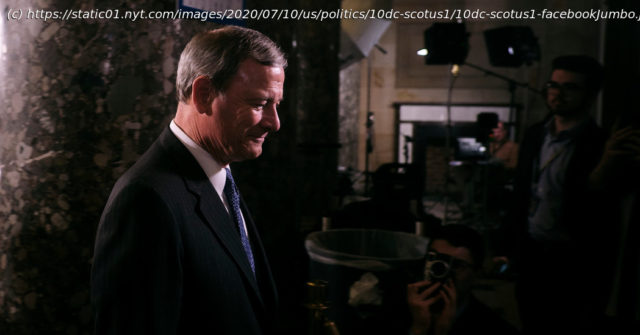Doling out victories to both sides, the court led by Chief Justice John Roberts seemed to strive to avoid charges of partisanship.
In an era of stark partisan polarization, Chief Justice John G. Roberts Jr. steered the Supreme Court toward the middle, doling out victories to both left and right in the most consequential term in recent memory.
The term, which ended Thursday, included rulings that will be taught to law students for generations — on presidential power and on the rights of gay and transgender workers. The court turned back an effort to narrow abortion rights, and it protected young immigrants known as Dreamers.
It expanded the role of religion in public life, and it cut back on the power of independent agencies. It took steps to prevent chaos when the Electoral College meets after the presidential election. And it handed Native Americans their biggest legal victory in decades.
A term that included just two or three such decisions would stand out. The term that just ended was a buffet of blockbusters.
It was also the term in which Chief Justice Roberts emerged as the member of the court at its ideological center, his vote the crucial one in closely divided cases, a role no chief justice has played since 1937. He was in the majority in all but one of the term’s 5-to-4 or 5-to-3 decisions.
But the chief justice was not alone in guiding the court toward the center: The percentage of 5-to-4 rulings dropped to a little more than 20, down from an average of 30 in the previous two terms.
Several major decisions were decided by 7-to-2 votes, including ones on subpoenas for President Trump’s financial records and the rights of religious employers. In some ways, the most prominent losers this term were the members of the court on its far right (Justices Clarence Thomas and Samuel A. Alito Jr.) and far left (Justices Ruth Bader Ginsburg and Sonia Sotomayor). They were the least likely to be in the majority in divided cases.
Chief Justice Roberts, 65, is a work in progress.
“This is the term where those of us who thought we understood John Roberts came to understand that we didn’t,” said Irv Gornstein, the executive director of Georgetown’s Supreme Court Institute. “I know some are already spinning out theories to explain how his votes fit into a coherent judicial philosophy. But as it was happening, it was one shock after another.”
In a two-week stretch last month, for instance, Chief Justice Roberts voted with the court’s four-member liberal wing in cases on abortion, the Dreamers and job protections for L. G. B. T. Q. workers.
The trend is clear, said Lee Epstein, a law professor and political scientist at Washington University in St. Louis. “He is drifting left at a statistically significant rate — and at a rate roughly resembling Souter’s liberal turn in the 1990s,” she said.
Justice David H. Souter, who was appointed in 1990 by President George Bush, soon emerged over his two decades on the court as a leading member of its liberal wing, much to the distress of his conservative sponsors.
Chief Justice Roberts dissented only twice in the entire term, in cases on unanimous juries and Native American jurisdiction over eastern Oklahoma. Put another way, he was in the majority in divided decisions at a higher rate than any chief justice since at least 1953. That and other conclusions in this article are drawn from data compiled by Professor Epstein, Andrew D.






